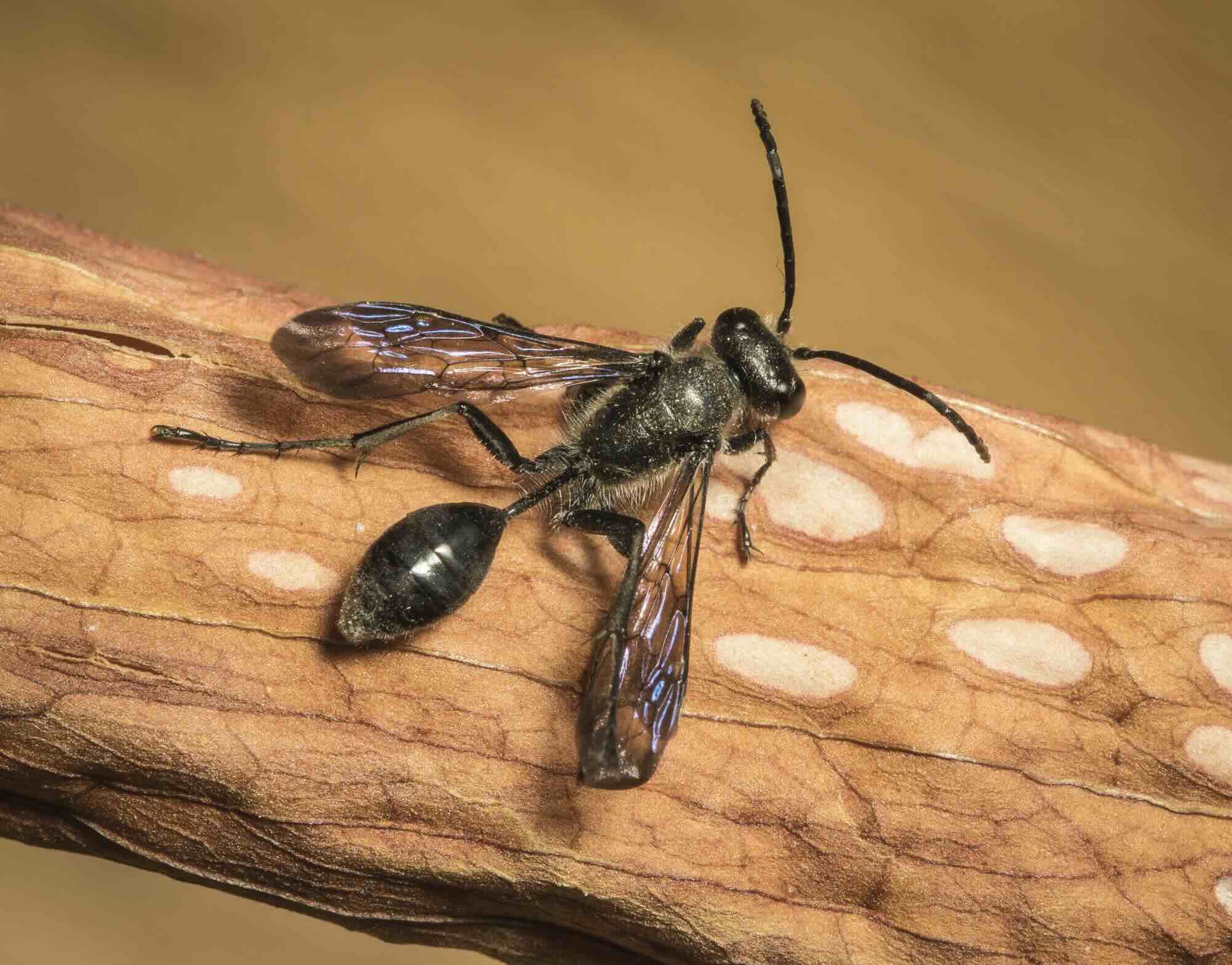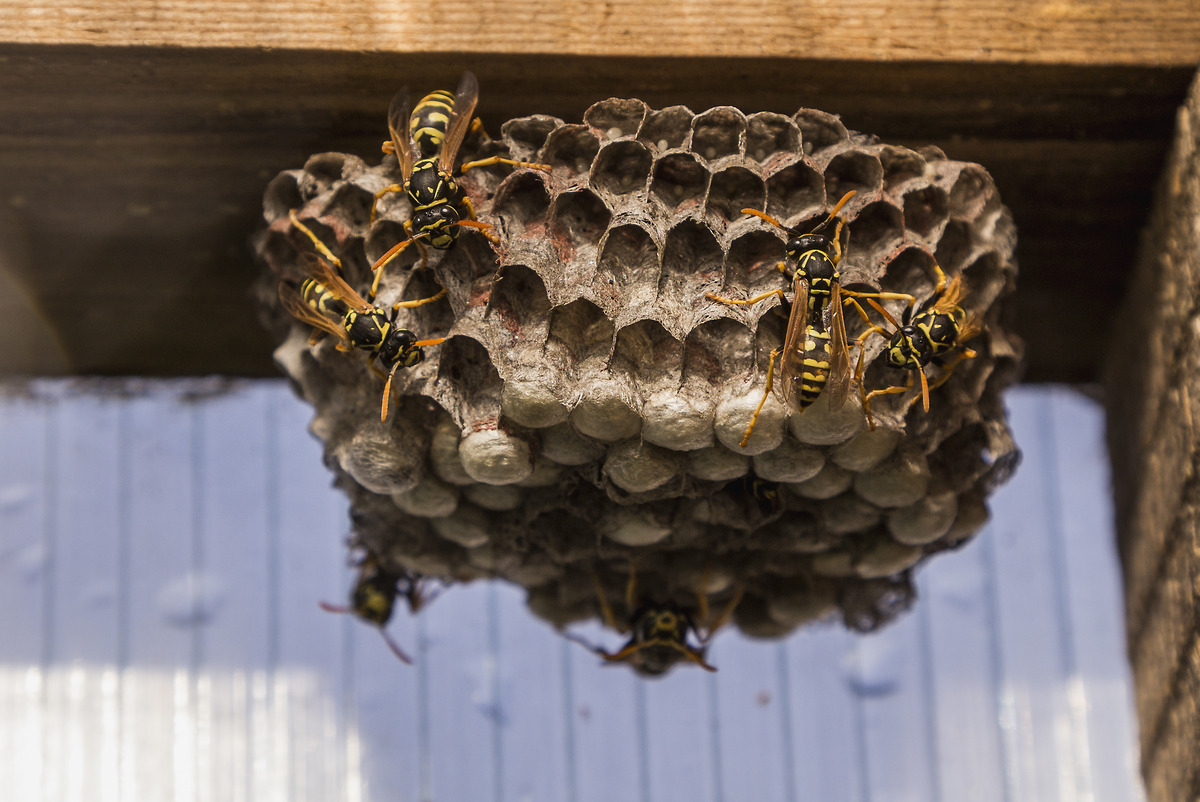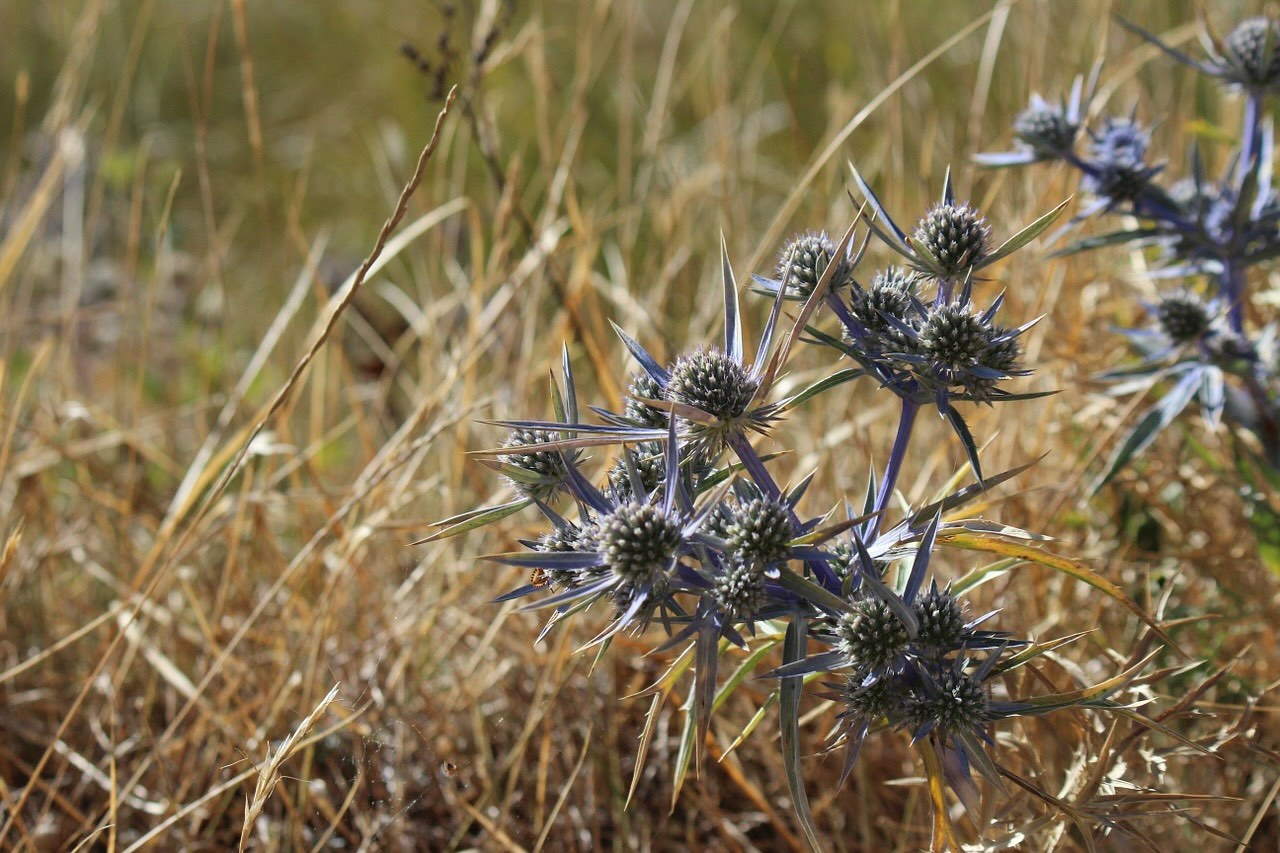Home>Gardening & Outdoor>Landscaping Ideas>How To Get Rid Of Grass-Carrying Wasps


Landscaping Ideas
How To Get Rid Of Grass-Carrying Wasps
Modified: August 20, 2024
Discover effective landscaping ideas to eliminate grass-carrying wasps from your yard. Follow our expert tips for a wasp-free outdoor space.
(Many of the links in this article redirect to a specific reviewed product. Your purchase of these products through affiliate links helps to generate commission for Storables.com, at no extra cost. Learn more)
Introduction
Are you noticing small, grass-carrying insects buzzing around your garden or yard? Chances are, you may be dealing with grass-carrying wasps. These fascinating creatures, also known as Bembix, are solitary wasps that are known for their unique nesting and hunting behaviors. While they are generally beneficial to the environment due to their role in pollination and pest control, their presence can sometimes become a nuisance, especially if they establish nests in high-traffic areas.
In this article, we'll explore effective methods for identifying, understanding, and managing grass-carrying wasps. Whether you're a gardening enthusiast, a homeowner, or simply someone who wants to coexist peacefully with these insects, this guide will equip you with the knowledge and strategies needed to address grass-carrying wasp infestations in a safe and environmentally friendly manner. So, let's delve into the intriguing world of grass-carrying wasps and learn how to manage their presence effectively.
Key Takeaways:
- Embrace the unique world of grass-carrying wasps by learning to identify, understand, and manage their presence in a safe and environmentally friendly manner. From their nesting habits to natural control methods, coexistence is possible.
- By integrating natural methods like strategic plant selection and encouraging natural predators, you can effectively reduce grass-carrying wasp presence while promoting a balanced and environmentally conscious outdoor environment. Prioritize safety and consider the broader impact when using chemical control measures.
Read more: How To Get Rid Of Wasps In The Attic
Identifying Grass-Carrying Wasps
Grass-carrying wasps belong to the Bembix genus and are commonly found in various parts of the world. These fascinating insects are relatively small, typically measuring around half an inch in length. They are known for their distinctive behavior of carrying small blades of grass or plant material in their mandibles, which they use to construct their nests. This behavior often makes them easily recognizable in outdoor spaces.
When observing grass-carrying wasps, you may notice their slender bodies, which are often black or dark brown in color. Some species may also display yellow or white markings on their bodies, adding to their visual appeal. Additionally, grass-carrying wasps have elongated wings that enable them to move swiftly and gracefully through the air as they search for prey and nesting sites.
One of the most notable features of grass-carrying wasps is their distinctive flight pattern. They are often seen darting and hovering near the ground, particularly in sunny, open areas such as sandy soil, bare patches of ground, or gravelly surfaces. As they search for prey and suitable nesting locations, they exhibit agile and purposeful movements that set them apart from other flying insects.
It’s important to note that while grass-carrying wasps may resemble other stinging insects such as yellow jackets or paper wasps, they are generally non-aggressive and pose minimal risk to humans. Unlike social wasp species, grass-carrying wasps are solitary and do not form large colonies, reducing the likelihood of aggressive behavior towards humans or pets.
By familiarizing yourself with the physical characteristics and behaviors of grass-carrying wasps, you can confidently identify their presence in your outdoor environment. This understanding serves as a crucial first step in effectively managing their impact and implementing targeted control measures.
Understanding Grass-Carrying Wasp Behavior
Grass-carrying wasps exhibit fascinating and intricate behaviors that contribute to their ecological significance and unique role in the natural world. By gaining insight into their behavior, we can develop a deeper appreciation for these remarkable insects while effectively managing their presence in our outdoor spaces.
One of the most striking aspects of grass-carrying wasp behavior is their nesting habits. These resourceful insects construct their nests in sandy or loose soil, often in sunny and open areas. Using their mandibles, they meticulously gather small blades of grass or plant material, which they transport to their chosen nesting sites. The collected vegetation is then used to create individual cells within the nest, where the female wasp will lay her eggs. This process showcases the remarkable nesting behavior that gives these insects their common name.
Grass-carrying wasps are also proficient hunters, preying primarily on small insects, particularly flies. They play a vital role in controlling fly populations, making them valuable allies in maintaining ecological balance. Upon capturing their prey, the wasps deliver the paralyzed insects to their nest cells, where they serve as a food source for the developing larvae. This hunting behavior not only sustains the wasp population but also contributes to natural pest control in the surrounding environment.
Another noteworthy behavior of grass-carrying wasps is their solitary nature. Unlike social wasp species that form colonies with a queen and worker castes, grass-carrying wasps are solitary creatures. Each female wasp constructs and provisions her own nest, ensuring that she can independently care for her offspring. This solitary lifestyle reduces the likelihood of aggressive behavior towards humans, as these wasps are primarily focused on nesting and hunting rather than defending a communal colony.
By understanding the nesting, hunting, and solitary behaviors of grass-carrying wasps, we can gain valuable insights into their ecological role and the factors that influence their presence in our outdoor environments. Armed with this knowledge, we can explore effective strategies for managing and coexisting with these remarkable insects in a harmonious and environmentally conscious manner.
Natural Methods for Eliminating Grass-Carrying Wasps
When it comes to addressing grass-carrying wasp presence in outdoor spaces, employing natural and eco-friendly methods can be an effective and sustainable approach. By leveraging non-toxic strategies, you can manage these insects while minimizing environmental impact and safeguarding the surrounding ecosystem. Here are several natural methods for eliminating grass-carrying wasps:
- Strategic Plant Selection: Consider incorporating plants that naturally repel insects, such as mint, basil, or marigolds, into your garden or landscaping. These aromatic plants can help deter grass-carrying wasps and other unwanted insects from frequenting the area.
- Modification of Nesting Sites: Since grass-carrying wasps prefer nesting in sandy or loose soil, modifying the landscape by adding mulch or ground cover to these areas can make them less appealing for nesting. By altering the texture and composition of potential nesting sites, you can discourage the establishment of new nests.
- Introduction of Predatory Insects: Encouraging the presence of natural predators of flies and other prey insects, such as predatory wasps or certain species of birds, can help naturally regulate the population of potential prey for grass-carrying wasps. This biological control method can contribute to a balanced ecosystem while reducing the availability of food sources for the wasps.
- Creation of Distraction Sources: By providing alternative food sources for grass-carrying wasps, such as a small dish of sugar water placed away from high-traffic areas, you can redirect their foraging activities and minimize their presence in spaces where human activity is frequent.
- Use of Essential Oils: Certain essential oils, such as citronella, peppermint, or eucalyptus oil, are known for their insect-repelling properties. Diluting these oils and using them to create natural sprays or diffusers can help deter grass-carrying wasps from specific areas without posing harm to the environment.
By incorporating these natural methods into your approach to managing grass-carrying wasps, you can effectively reduce their presence while promoting a balanced and environmentally conscious outdoor environment. These strategies offer sustainable solutions that align with principles of ecological harmony and responsible pest management.
To get rid of grass-carrying wasps, locate their nests in the ground and carefully apply an insecticidal dust directly into the nest entrance during the evening when they are less active. Wear protective clothing and follow the product’s instructions carefully.
Using Chemical Control for Grass-Carrying Wasps
While natural and eco-friendly methods are often preferred for managing grass-carrying wasps, there are situations where targeted chemical control measures may be considered appropriate. It’s important to approach chemical control with caution and prioritize the safety of humans, pets, and the environment. When implementing chemical control for grass-carrying wasps, consider the following approaches:
- Dust or Powder Insecticides: Selective application of dust or powder insecticides labeled for wasp control can be used to treat specific nesting sites of grass-carrying wasps. These insecticides should be applied directly into the nest entrances during the evening when the wasps are less active, minimizing the risk of direct contact.
- Liquid Insecticides: Liquid insecticides formulated for wasp control can be applied to targeted areas where grass-carrying wasps are active, such as nesting sites or foraging areas. It’s essential to follow the product instructions carefully and apply the insecticide during periods when human and pet exposure can be minimized.
- Professional Pest Control Services: In cases where grass-carrying wasp infestations pose significant challenges or safety concerns, seeking assistance from licensed pest control professionals may be warranted. Professional exterminators can assess the situation, apply appropriate insecticides, and implement control measures in a safe and effective manner.
When using chemical control methods, it’s crucial to prioritize safety and adherence to product labels and guidelines. Always store and handle insecticides according to the manufacturer’s instructions, and take necessary precautions to prevent unintended exposure to humans, pets, and non-target organisms. Additionally, consider the potential impact on beneficial insects and pollinators when utilizing chemical control measures, and strive to minimize collateral harm to the surrounding ecosystem.
Prior to implementing chemical control for grass-carrying wasps, carefully evaluate the severity of the infestation and the suitability of alternative control methods. By exercising prudence and considering the broader implications, you can effectively manage grass-carrying wasps while upholding responsible stewardship of the environment.
Read more: How To Get Rid Of Wasps In Eaves
Preventing Grass-Carrying Wasps from Returning
After addressing the presence of grass-carrying wasps in your outdoor environment, it’s essential to implement preventive measures to deter their return and maintain a harmonious coexistence with these insects. By taking proactive steps to create an environment that is less conducive to grass-carrying wasp nesting and foraging, you can minimize the likelihood of future infestations. Here are effective strategies for preventing grass-carrying wasps from returning:
- Regular Nest Inspection: Routinely inspect potential nesting sites, such as sandy or loose soil areas, to identify and address any new nest formations promptly. By remaining vigilant and proactive, you can prevent the establishment of new grass-carrying wasp nests before they become sizable colonies.
- Landscape Maintenance: Maintain a well-groomed landscape by regularly mowing the lawn, trimming vegetation, and removing excess debris. By keeping the outdoor area tidy and free of overgrown vegetation, you can create an environment that is less attractive to grass-carrying wasps seeking nesting sites.
- Sealing Entry Points: Seal off potential entry points to buildings, sheds, and other structures to prevent grass-carrying wasps from accessing indoor spaces. Use caulk or weather-stripping to close gaps and crevices, reducing the likelihood of wasp intrusion into human-occupied areas.
- Installation of Wasp Traps: Deploy commercially available wasp traps in outdoor areas to intercept and capture grass-carrying wasps. These traps can help reduce the local population of foraging wasps, minimizing their presence in high-traffic zones and recreational spaces.
- Encouragement of Natural Predators: Foster a habitat that supports the presence of natural predators of grass-carrying wasps, such as certain bird species and predatory insects. Creating a biodiverse and ecologically balanced landscape can contribute to natural regulation of grass-carrying wasp populations.
By integrating these preventive measures into your outdoor maintenance routine, you can create an environment that is less hospitable to grass-carrying wasps, reducing the likelihood of recurrent infestations. These proactive strategies align with principles of sustainable pest management and environmental stewardship, fostering a harmonious coexistence with these remarkable insects.
Conclusion
Grass-carrying wasps, with their unique nesting behaviors and valuable ecological contributions, are intriguing inhabitants of outdoor environments. While their presence can sometimes pose challenges, it’s important to approach their management with a balanced perspective that prioritizes environmental responsibility and coexistence. By understanding the characteristics and behaviors of grass-carrying wasps, we can implement effective strategies for addressing their presence while respecting their role in the ecosystem.
From identifying and understanding grass-carrying wasps to implementing natural and, when necessary, chemical control measures, this guide has provided comprehensive insights into managing these remarkable insects. By leveraging natural methods such as strategic plant selection, modification of nesting sites, and the introduction of predatory insects, we can reduce grass-carrying wasp presence in a sustainable and environmentally conscious manner.
When chemical control measures are warranted, it’s crucial to exercise prudence, prioritize safety, and consider the broader impact on the environment. By utilizing targeted insecticides judiciously and seeking professional assistance when needed, we can manage grass-carrying wasps effectively while minimizing unintended consequences.
Furthermore, implementing preventive measures such as regular nest inspection, landscape maintenance, and the encouragement of natural predators can help deter grass-carrying wasps from returning, fostering a balanced and harmonious outdoor environment.
Ultimately, by approaching the management of grass-carrying wasps with a holistic understanding of their behavior and ecological role, we can coexist with these insects in a manner that respects the delicate balance of the natural world. Through responsible stewardship and informed decision-making, we can create outdoor spaces that are both inviting to humans and conducive to the thriving of diverse insect species, including the fascinating grass-carrying wasps.
Frequently Asked Questions about How To Get Rid Of Grass-Carrying Wasps
Was this page helpful?
At Storables.com, we guarantee accurate and reliable information. Our content, validated by Expert Board Contributors, is crafted following stringent Editorial Policies. We're committed to providing you with well-researched, expert-backed insights for all your informational needs.















0 thoughts on “How To Get Rid Of Grass-Carrying Wasps”